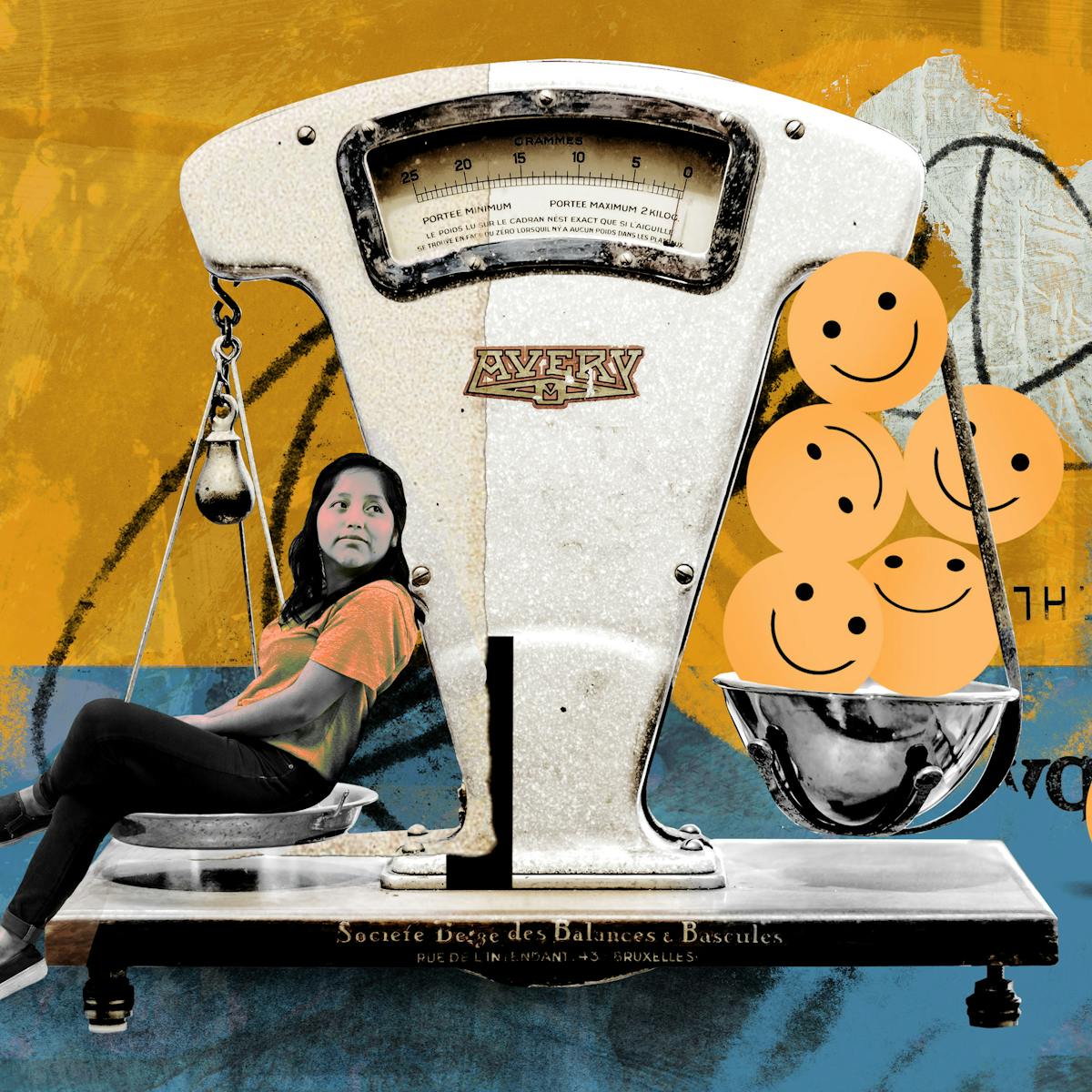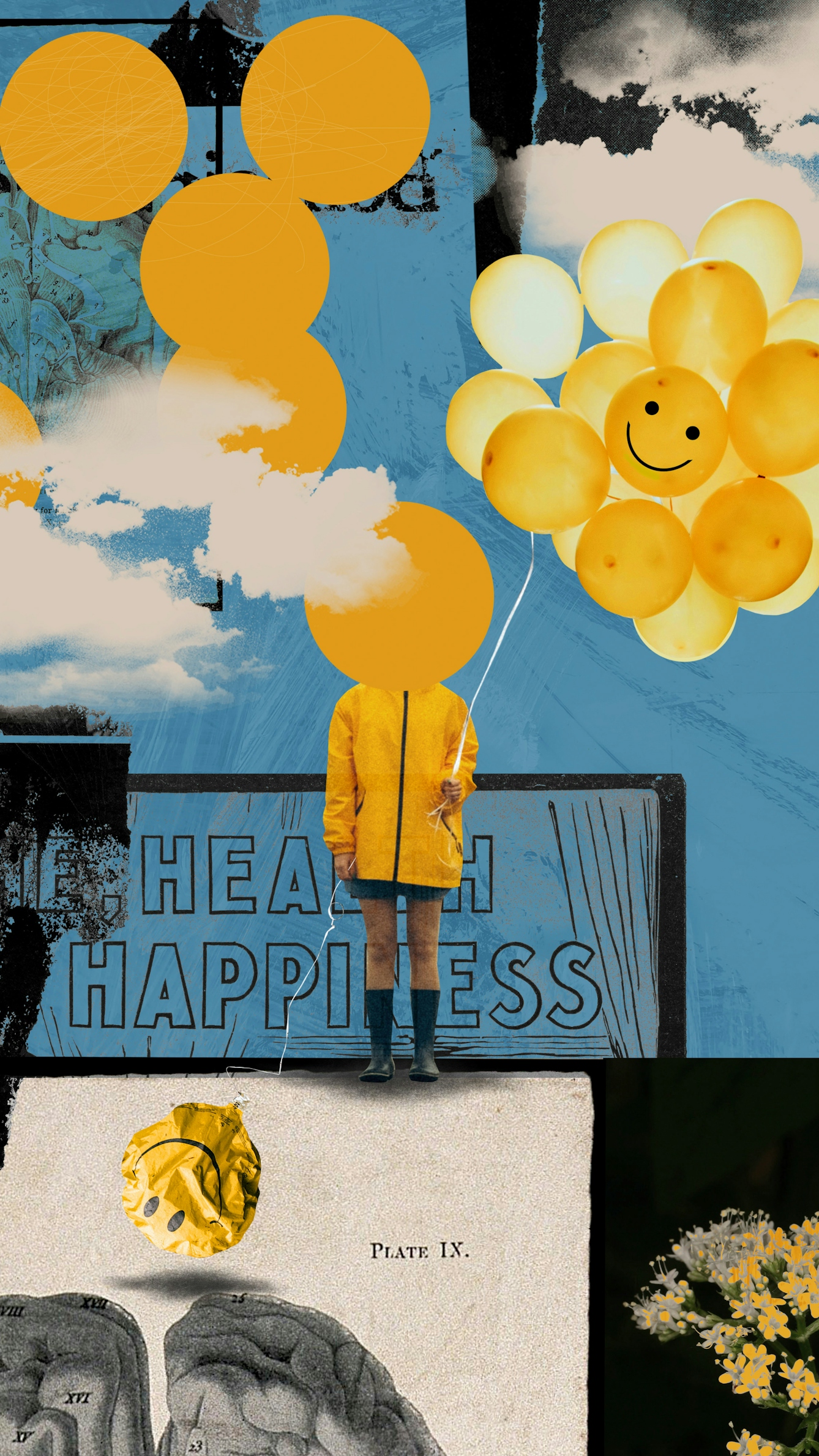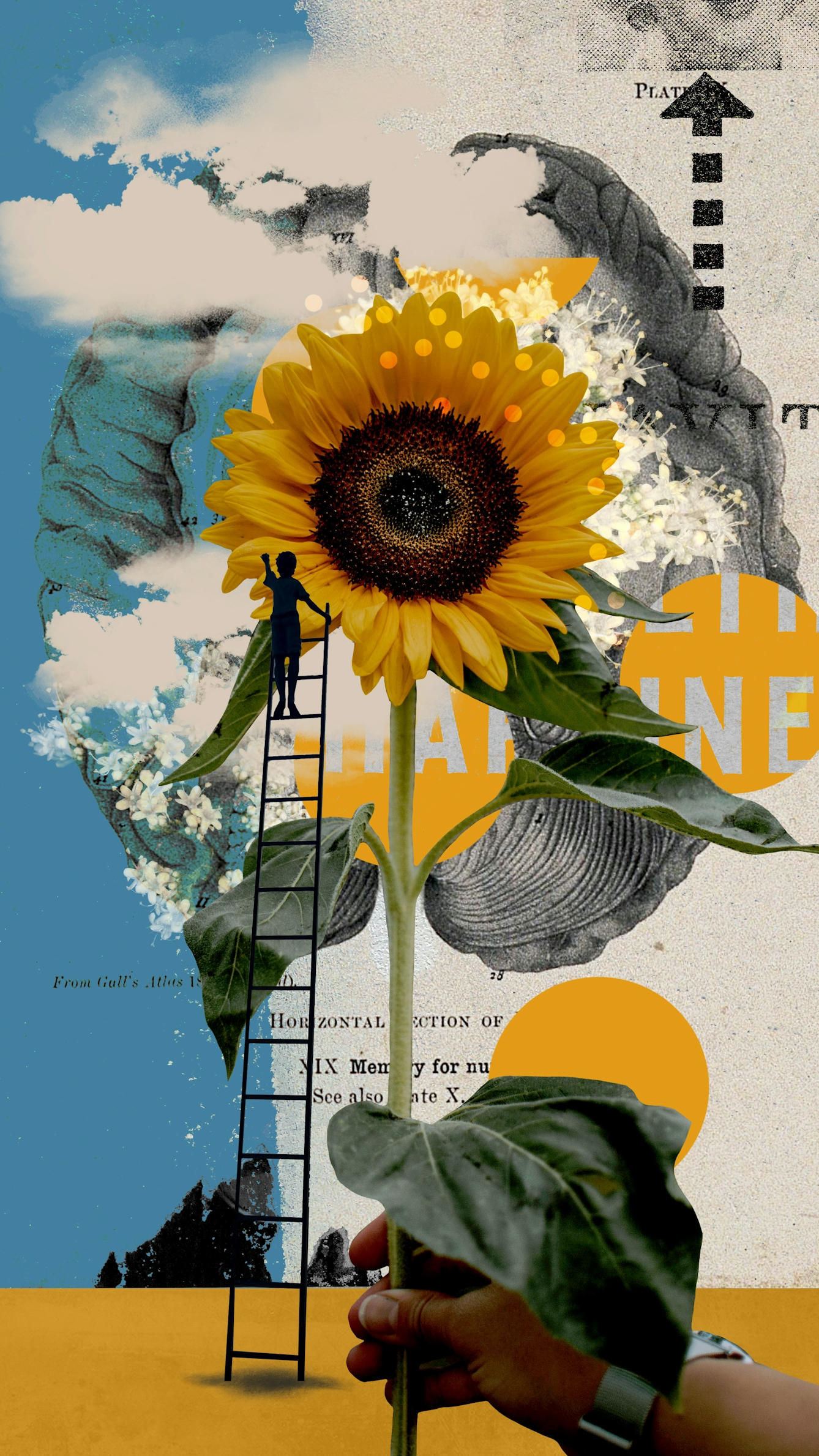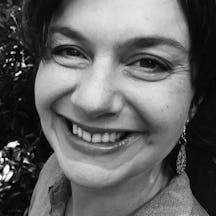How do we describe what it means to be happy? In this extract from ‘The Book of Human Emotions’, cultural historian Tiffany Watt Smith charts how the definition of happiness has changed over time, from chance emotion to something that can be measured and controlled. Would reclaiming it as something fleeting and complex make us happier?
The meaning of happiness
Words by Tiffany Watt Smithartwork by Eleanor Shakespeareaverage reading time 8 minutes
- Book extract

He sits with his young daughter in a café near his city home in Sweden. She drinks lemonade and asks questions about the sky and skeletons. He concocts fanciful answers.
“Even if the feeling of happiness this gives me is not exactly a whirlwind but closer to satisfaction or serenity,” writes the Norwegian author Karl Ove Knausgård in his autobiographical ‘A Death in the Family’, “it is happiness all the same.”
But moments later, the old worries curl up around him and settle into their familiar routine. Is this all he is capable of, he wonders, this pale version of other people’s exhilaration? If he hadn’t chosen books over family, might his life be jingling with joyful laughter too?
“We could have lived somewhere in Norway, gone skiing and skating in winter... and boating in the summer, swimming, fishing, camping... we could have been blissfully happy.”
This is the thing about happiness. As the philosopher J S Mill put it, “Ask yourself whether you are happy, and you cease to be so.”
The happiness industry
Today happiness is a multimillion-pound industry. Self-help books encourage us to track our emotional temperatures. There are apps that turn the effects of certain foods and exercise on our moods into graphs.
This increased self-consciousness about happiness occurs on an international level too – since 2003, the EU has measured and compared the happiness of people in its member states, a barometer watched eagerly by politicians, as happiness has become a shorthand for that other ubiquitous goal: ‘wellbeing’.
And the stakes are high. You’d be hard-pressed to find a book on happiness that does not cite studies showing that a cheerful disposition makes you live longer, or that people who enjoy life are more successful at work.
If something seems important, we want to control it; if we want to control it, we measure it first. But in our hurry to weigh and measure that most subjective, fleeting experience of happiness, we might be forgetting to check first what we’re putting at risk.

“As the philosopher J S Mill put it, ‘Ask yourself whether you are happy, and you cease to be so.’”
The dutiful pursuit of pleasure
The idea that happiness can be generated and controlled is relatively new. From the Old Scandinavian root happ (chance, luck or success), before the 18th century, the word ‘happiness’ most often described feeling that God’s grace was shining upon you. Though it described a state of pleasure and contentment, it was connected more with good fortune than engineering: happiness was there when things went your way – a happy fit, a happy coincidence, happenstance.
This link between happiness and chance seems to have subtly shifted around the 18th century. In 1776 Thomas Jefferson declared in the American Constitution that every citizen had a right to “life, liberty and the pursuit of happiness”, as if happiness was something that could be sought out, even captured.
Meanwhile in Britain, making happiness one’s life’s ambition seemed to have become such a fashion among the educated elite that wits such as Alexander Pope ridiculed it: “O Happiness! Our Being’s End and Aim! Good, Pleasure, Ease, Content! Whate’er thy name.” Some historians have even linked the rise of interest in happiness with improvements in the period’s dentistry and the subsequent willingness to flash a toothy smile.
The imperative to be happy was swiftly followed by attempts to parse and catalogue it – so as to work out what might stand in its way. One of the best-known examples remains the hyper-rational philosophy Utilitarianism. In 1776, the same year as the American Constitution was sealed, the British lawyer Jeremy Bentham put together his unintentionally louche-sounding “catalogue of pleasures”.
Arguing a moral decision was one that increased the total sum of happiness in the world, Bentham made an inventory of things that – according to an 18th-century male lawyer – produced pleasure (things like skill, power and piety), and things that caused pain (such as privation, awkwardness or having a bad reputation).
If you needed to make a decision, for example whether to visit your elderly parents, you simply had to dig out your catalogue, tot up which pleasures it produced, subtract the total pains it created, and then if the pleasures outweighed the pains, you could plan your visit.
Bentham’s felicific calculus has come in for quite a beating from philosophers over the years. What brings people pleasure is clearly subjective – and as a guide to behaviour, it is clearly problematic, making no effort to exclude actions that are morally bad (such as torturing a cat) but that might bring someone pleasure. But was he so different from today’s proponents of “the new science of happiness” whose goal it is to maximise happiness and dedicate reams of paper to working out precisely how?
One person who had a particularly violent reaction to Bentham’s happiness agenda was his prodigy and godson, J S Mill. Raised on strict utilitarian principles, Mill was able to spew out hedonic calculations along with his Latin verse aged nine. The only problem was that he wasn’t happy at all.

“Happiness couldn’t be pursued or grasped. Like luring a cat to sit on your knee, happiness had to be ignored rather than cajoled.”
In his late teens, Mill experienced a period of prolonged mental anguish and melancholy. After his recovery (which he said was achieved by reading poetry), Mill came to believe that happiness was rather more complicated than Bentham had understood.
Even if happiness was the goal of life, he believed it couldn’t be pursued or grasped… he saw it as a shy sort of feeling, sneaking up when you least expect it.
Even if happiness was the goal of life, he believed it couldn’t be pursued or grasped. Like luring a cat to sit on your knee, happiness had to be ignored rather than cajoled: he saw it as a shy sort of feeling, sneaking up when you least expect it.
“Let your self-consciousness, your scrutiny, your self-interrogation exhaust themselves on [a different goal],” wrote Mill. “And if otherwise fortunately circumstanced, you will inhale happiness with the air you breathe, without... putting it to flight by fatal questioning.”
Leading a satisfying life
When someone asks if you are (a) very happy (b) quite happy or (c) not very happy at all, you might wonder whether all this “fatal questioning” might be putting us on the brink of a mental crisis of our own. Perhaps the idea that happiness is obligatory, or else that we are entitled to it, or else that we have failed if we can’t achieve it can make us anxious and dissatisfied.
One response to this dilemma is to reject the term altogether. Many contemporary philosophers and psychologists, including Martin Seligman, one of the founders of the positive psychology movement, prefer to use the term ‘flourishing’ rather than happiness. A rough equivalent of the Greek term eudaimonia, the most influential account of which appears in Aristotle’s ‘Nicomachean Ethics’, it suggests that a meaningful life is full of pains as well as privileges.
While happiness has come to be associated with a generalised positive feeling, to lead a flourishing life demands that you practise courage (which can be difficult), and compassion (which can lead to sadness felt on behalf of others), and deferred gratification (which means you might have to experience the frustrations of waiting). Leading a flourishing life might not be all swimming and fishing in Norway, but it might be, according to Seligman and his colleagues at least, a more satisfying way to live.
Perhaps the greatest consequence of replacing talk of happiness with talk of flourishing will be to restore to happiness to its rightful place as an emotion. Over the last 200 or so years, happiness has come to be mean more of a condition or state of the happily-ever-after variety than a temporary feeling which, like all emotions, may sometimes be present and sometimes not.
It may not even always be desirable: as researchers in the Journal of Happiness Studies recently showed, not all cultures automatically desire happiness – their interviews suggested that New Zealanders are particularly nervous about happiness, subscribing to a “what goes up must come down” attitude; while in the Ifaluk culture of Micronesia, expressing happiness is “associated with showing off, overexcitement and failure at doing one’s duties”.
If we reclaim our happiness as a feeling that is as fleeting as surprise, or as complex as grief, we may find many shades and contradictions. Because while for one person happiness is an uninhibited groan of contentment, and for the next an eerie sense of everything being “just right”, and for a third a fluttering of excitement, it’s also an emotion that feels dangerous, and daring, a “perfect bridge over the crocodiles”.
‘The Book of Human Emotions’ is out now.
About the contributors
Tiffany Watt Smith
Tiffany Watt Smith is a cultural historian and author of ‘The Book of Human Emotions’. Her TED talk ‘The History of Human Emotions’ has been viewed by more than four million people. She regularly appears as an expert contributor on BBC radio and her writing has appeared in the Guardian, the New Scientist and BBC News Magazine, among others. She is Reader in Cultural History at Queen Mary University of London, where she is also Director of the Centre for the History of Emotions. In 2018 she was awarded the Philip Leverhulme Prize for her research.
Eleanor Shakespeare
Eleanor is a photomontage illustrator based in South London. Her work comprises photographic ephemera with bold colour palettes, handmade textures and mark-making to suit a wide variety of contexts. Eleanor enjoys the challenge of tackling all kinds of weird and wonderful subject matter, using found material to create truly unique illustrations. She has worked with clients worldwide, including the New York Times, the Guardian and TIME magazine. She has a kitten called Earl, who likes to try and help out around the studio.

